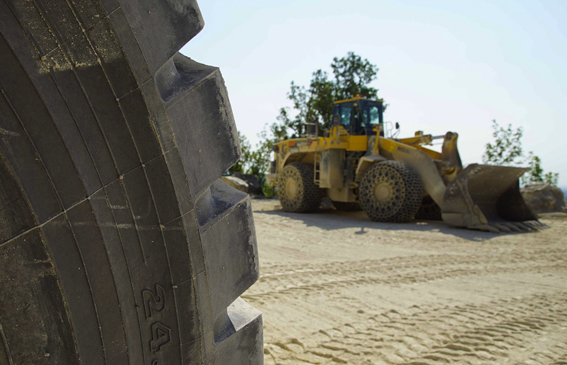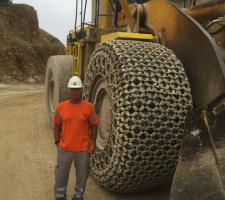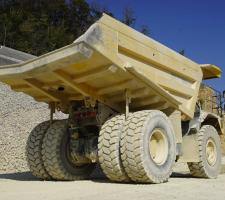
The use of retread tyres is an interesting market in quarrying that can offer potentially significant cost savings for quarry operators. Liam McLoughlin reports.
The retread market for tyres has been established for around 60 years, but demand increased around a decade ago when there was a global shortfall in the supply of new OTR (off the road) tyres for quarrying vehicles. The shortage was caused by the construction and mining “bubble” and a consequent high demand for OTR tyres that new tyre producers were not ready to meet. Some quarry managers turned to retread companies to prolong the life of existing tyres and prevent vehicles having to be parked up.
Retreads are used in quarrying on all the major vehicles - wheeled loaders, RDTs (rigid dump trucks) and ADTs (articulated dump trucks).
The main benefit of retreads (also known as remoulds) to operators is cost saving, which was stressed by a number of quarry managers that Aggregates Business Europe spoke to during a recent site visit to Slovakia. Luca Mai, sales director at retread company
“Quarry customers are mostly focused on the cost-saving aspect - reducing their total costs of ownership and hourly costs,” according to Ayhan Haliloglou, area manager at Marangoni. “For them the most important thing is that their production continues to run, and they also want reliability and safety.”
The Dolvap quarry near Zilina in north-west Slovakia, which processes around 1.5 million tonnes of Dolomite limestone a year, has been using retreads from Italy-based Marangoni since 2008. It moved to using retreads after experiencing problems in obtaining new premium tyres and is pleased with the results, according to quarry manager Ľuboslav Kuba.
“Each retread tyre has about 3,300 hours life, which represents around 12 to 18 months of working life,” says Kuba, who has worked at the site for 42 years. “This is equivalent to 80-90% of the 3,800-hour lifespan for a new premium OTR tyre. It varies depending on factors such as the weather and the driver.”
The quarry currently uses retreads on two of its wheeled loaders - a
The specific conditions at quarries affect how retreads are used according to Peter Hemčik, manager at MZ Pneu, the service provider for Marangoni that supports the companies visited by Aggregates Business Europe in Slovakia. “At the Butkov limestone quarry, 60km from Slovakia’s fourth biggest city of Zilina, new tyres rather than retreads are always used on the front of vehicles to gain the optimum performance,” he says. “This is due to the steep inclination vehicles must travel down, which shifts a lot of the weight onto the front tyres.”
The quarry currently uses retreads on the rear of four of its seven vehicles. These are a Volvo L350 wheeled loader, a Komatsu WA600 wheeled loader, a Komatsu HD405 RDT and a Cat 772 RDT.
“Using old casing and retreading it gives the tyres long life,” says assistant quarry manager Miroslav Sedik. “It’s economical for the company and has ecological benefits with less need for natural resources compared to new tyres.”
He adds that having good traction on tyres is extremely important for the quarry in winter, and the retreads have produced a good performance in these conditions.
The Kamenolom Solosnica quarry, which is operated by aggregates producer Alas near the Slovak capital Bratislava, currently uses Marangoni retreads on its two Cat 771 RDTs and a Komatsu HD405 wheeled loader.
“The benefit of retreads for us is that we pay 50% of the price for a new tyre, but the lifetime of the retread is much more than 50%,” says Kamenolom Solosnica quarry manager Peter Hoffman.
As with other quarries, the supply issue was also a major factor in the decision to consider the use of retreads. “We were having to wait a minimum of two or three months for a new tyre, whilst we could get a retread from Marangoni in one to a maximum of three weeks,” says Hoffmann.
The Lom Vajarská quarry, also close to Bratislava, produces a special type of white cement. It employs Marangoni retreads on nine of its dumpers and loaders. They are used on the rear axle of the Komatsu HD605 dumpers with new premium tyres on the front axle. Retreads are used on both the front and rear axles of the quarry’s Komatsu WA700 and Komatsu WA600 loaders.
Quarry manager František Ambra says: “When using retread tyres we save about 50% of the cost [of a new tyre] - we can use the casing more times and it is economical and very ecological.”
The market for the new premium OTR tyres used in quarrying is dominated by Japan’s
The retread companies are not a competitor to new premium tyre suppliers but complement them, according to Haliloglou. “You will always need new tyres to buy the retreads,” he says. “You need the casing from the existing tyre to do the retread, so the casing needs to have been well-maintained. We always say you should run premium new tyres and premium retreads together. We position ourselves as a premium retread equivalent to the major players.”
Marangoni offers a five-year guarantee on all its premium products, the same as the premium new tyre suppliers. The guarantee covers the tyre casing in addition to the retread. Mai stated: “The company can commit to this because of the implementation of high technical production standards, such as the extensive usage of shearography to identify all possible defects, both during initial inspection and final testing of the retread.
“The special care paid to casing selection and evaluation is crucial because, in order to produce our retreads, we use only the best casings.”
Haliloglou says there are also environmental and recycling benefits from the extension to tyre life cycles that is provided by retreads.
“There are a lot of quarries with stacks of tyres hanging round that they can’t get rid of,” he adds. “By using retreads you will reduce the amount of tyres you need to scrap, which is a very compelling argument for their use in terms of cutting recycling costs. We tell quarry managers to take care of their tyres and remove them when they have a few millimetres of tread left so they can be given re-treads.”
Quarries would often dispose of old tyres in landfill, but this practice has been banned in the European Union for more than a decade. As a result, according to an ETRMA (European Tyre and Rubber Manufacturers’ Association) report on the disposal of pneumatic tyres, only 4% of all used tyres in EU-28 countries are now tipped in landfills.
Consistent with its long-term vision about the circular economy, Marangoni says its focus is more than ever aimed at prolonging tyre life and at favouring a repeated use of the products. In concrete terms, that means developing high-performing compounds and promoting among the end users the culture of tyre maintenance.
“Thanks to retreading, you use a casing which has already been produced and you can get one or maybe more additional life cycles out of the tyre, so it significantly reduces the impact on the environment,” says Mai. “However, in order to return in service with a new tread, the tyre structure must be deemed fit for the retreading process. Only good quality tyres that have been used and maintained correctly can usually withstand multiple tread lives,” he adds.
The tread of industrial tyres has a shorter life than a premium casing. The casing is the inner structure of the tyre underneath the tread, sidewall and steel belts. According to Marangoni, a 35/65R33 new tyre weighs around 1,050kg, of which around 700kg consists of the tyre structure. It adds that remanufacturing that tyre to create one of its retreads means using only around 350kg of materials for the new tread.
“If you compare the retread process to that of producing a new tyre, you don’t need any steel for a retread as it is already there in the casing,” says Haliloglou. “For an average OTR tyre you also need around 60% less rubber and oil, and the production process uses much less energy.”
The reduction in raw materials used also contributes to less CO2 emissions. According to Marangoni, using four 23.5R25 retreads for a wheeled loader (for example a Cat 950 GC), instead of four new tyres means approximately 2,500kg less CO2 emissions (equivalent to one year of emissions for an 80m2 apartment). There are three main factors affecting the wear of tyres in quarrying environments: distance and speed, air pressure and load. All these factors influence the heat generation of the tyre.
“The tyre’s enemy is the heating issue, especially with haulage tyres,” says Haliloglou. “Heat-resistant tyres are designed for dump trucks that do longer distances and have heavy loads. The compound on the tread is what makes the difference in the performance. A correct compound will not heat as much as an incorrect one, and it will also be more resilient against damage.”
There are four types of Marangoni tread compound used in the company’s retreads, which cater for differing environments and workloads.
The W2 compound is designed to withstand cuts and tears and is intended for use when operating with extreme high loads and in severe work conditions. The W1 is recommended to withstand cuts and tears at higher average speeds than with compound W2. The H2 compound is recommended for medium-distance travel and higher speeds than the ideal levels for W1. H1 offers better resistance to generation of heat internally when operating on relatively even surfaces (less severe use).
















